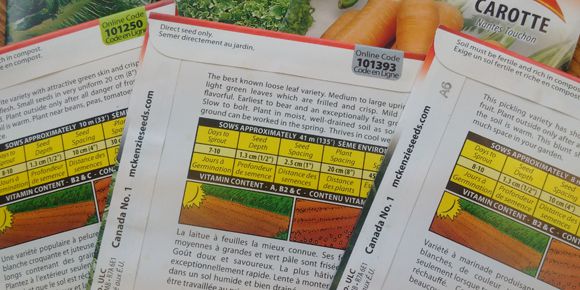Seed packages
Seed packages will usually tell you the number of days to germination, the depth to sow the seeds, how far apart to sow them, growth height and whether the seed is an annual, biannual or a perennial. It should tell you approximately when to plant – usually a time determined in relation to the average last frost days or before the first frost. The package may add thinning instructions (especially for tiny seeds or root vegetables).
Some seed packages will give you a best-before date, but this doesn’t mean that the seeds have all expired past that date – simply that beyond that date not as many will germinate. The packet may also provide you with a guaranteed germination rate if seeds are planted by the best-before date.
Seed packets often provide information about watering, soil, harvesting and seed storage.
Some seed packets will tell you if the seeds are a cultivar or a heritage seed. Many cultivars will not come true to the parent if planted from saved seeds. Heritage seeds often produce more flavourful fruit (as in tomatoes) and saved seeds will produce offspring that resemble their parent.
“Organic” simply means that the seed has not been treated with any substances, such as preservative coatings that fall outside the rules for the organic labeling.
Plant tags
Even the best gardeners today use already started plants. Their plant tags, aside from providing information about growing conditions, often devote space to identifying their patents and their exclusive rights to propagation.
PPAF stands for Plant Patent Applied For and once the plant has been patented, these letters will be replaced by the patent number itself. Sometimes patented plants will be followed by the words “Propagation strictly prohibited”, meaning that taking cuttings to start new plants is a no-no, although the main concern is to prevent commercial growers from doing this.
A plant name followed by a circled “r” or the letters “tm” mean registered or trademark. This refers only to the right to use the name of the plant. “Registered” does not carry the same legal weight as “Trademark”.
If the plant is a hybrid, this will usually be indicated on the tag and it should be noted that many hybrids are sterile and cannot be propagated from seed or, if seed is collected, then the next plant will not come true to the original.
One unreliable bit of information on plant tags is the light requirement, because the information is dependent on where the plant was “trialled” (tested by growing) and under what light conditions.
If the plant trials took place in a climate similar to yours, no problem. But what if the plant was trialled in a cloudy or temperate part of the continent and where you live is in hot, bright sunshine? The light requirements may vary greatly, so the final arbiter of the information has to be you and your keen eye. If a plant marked “sun” is frying in the midday sun, move it to a partially shaded location. Note that many Canadian plants are trialled in Michigan or even on the British Columbia coast, where the sky is often overcast. Always take your plant tag light information with a grain of salt.
Plant Spacing Information
Another bit of advice you might want to use only as a guideline is the plant spacing information. This usually occurs as advice that says something like “space 12 inches apart”. Use this as a guideline but remember that your own garden conditions may be different from those ideal conditions where the plant was trialled. You may want to space a little closer or further apart depending on your local circumstances and how you want
your garden to look. Spread information is more reliable as it tells you how wide the plant will grow and you can decide on the spacing yourself.
Finally, every grower seems to use a different system of symbols to communicate plant uses and culture, but generally a pair of scissors indicates a cutting flower; the sun, half sun or black sun indicates the amount of light required; a vessel of water shows how much moisture the plant requires.



